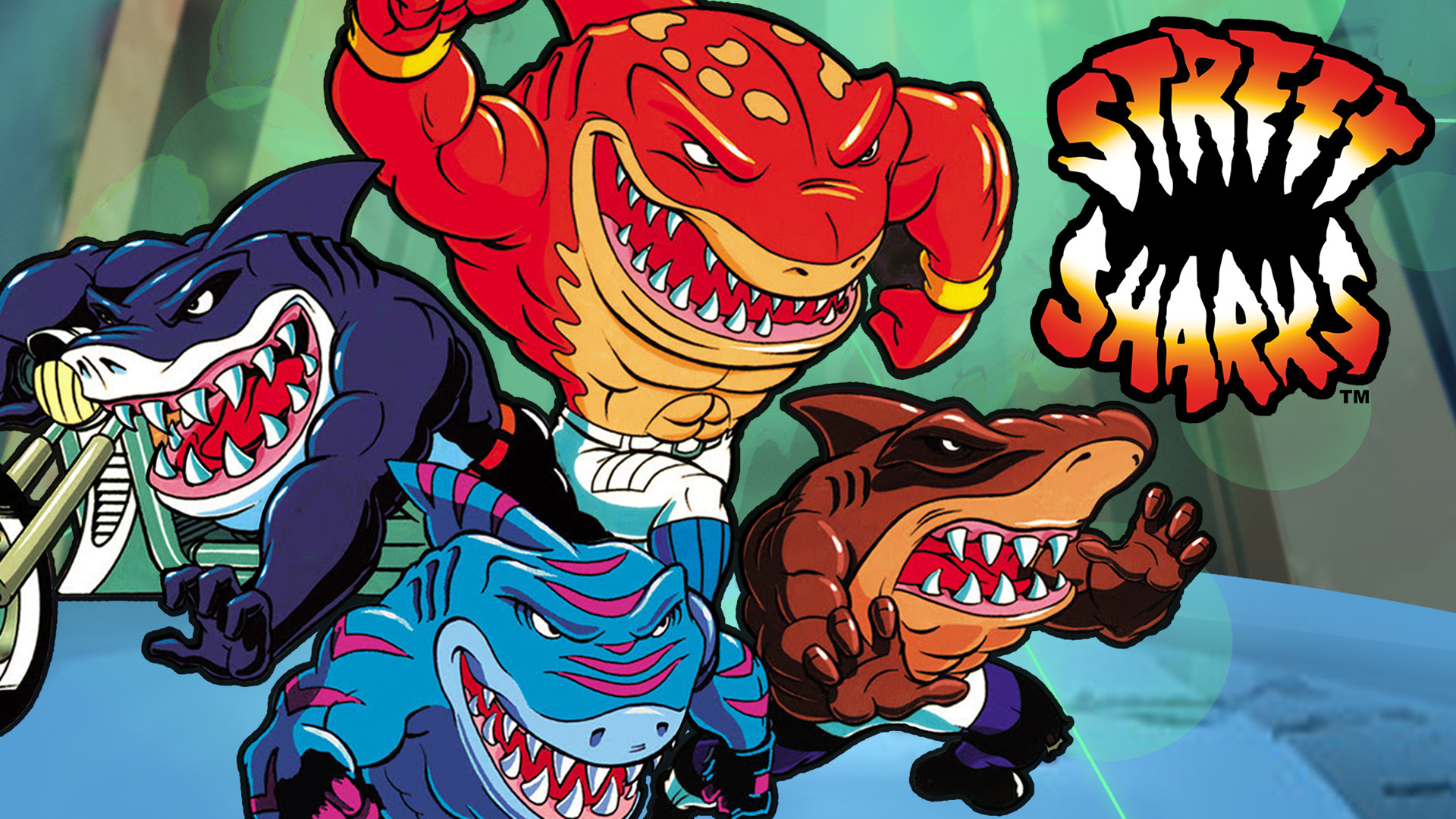introduction to Street Sharks
In the vast ocean of 1990s cartoons, few series made as big a splash as Street Sharks. While other animated shows like Teenage Mutant Ninja Turtles or X-Men might have dominated the headlines, Street Sharks earned its cult following through its wild premise, memorable characters, and over-the-top action sequences. But what exactly made Street Sharks stand out from the crowded cartoon landscape, and why do fans still look back on the show with fond nostalgia?
Street Sharks first aired in 1994 and quickly became a cultural touchstone for kids of that generation. Created by DIC Productions, this series had all the hallmarks of a classic ’90s cartoon: mutants, high-octane action, and a memorable theme song. The premise was simple but effective: four brothers were turned into half-man, half-shark mutants and vowed to protect their city from the forces of evil. While the concept might seem bizarre at first glance, the show leaned into its absurdity, which is precisely why it resonated with its audience.
In this guide, we’ll dive deep into everything Street Sharks—its origins, characters, cultural impact, and why it still holds a special place in the hearts of many. Whether you’re a longtime fan or new to the Street Sharks universe, this article will give you an in-depth look at one of the most iconic animated series of the ’90s.
1. The Birth of Street Sharks: How It All Began
Street Sharks didn’t emerge out of nowhere; it was a product of the booming action-figure market of the 1990s, where toy companies were looking for the next big hit. At the time, Teenage Mutant Ninja Turtles had set the gold standard for transforming a wacky cartoon premise into a multimillion-dollar franchise. Toy companies saw the potential of merging creatures and action heroes, creating an explosion of similar concepts. Enter Street Sharks.
1.1 The Concept and Development
Street Sharks was developed by DIC Productions, a company that had already gained a reputation for producing beloved animated series like Inspector Gadget and The Real Ghostbusters. With an eye on the success of mutant-themed shows, DIC wanted to replicate the winning formula of Teenage Mutant Ninja Turtles but with a new twist—this time, sharks instead of turtles.
The creators envisioned a world where four brothers were transformed into humanoid sharks after a science experiment gone wrong. Their goal? To battle the evil scientist responsible for their mutation and protect their city from monstrous villains. Each of the four brothers was based on a different species of shark, adding unique abilities and personalities to the mix.
1.2 Partnering with Mattel: The Toy Tie-In
No 1990s cartoon was complete without an accompanying toy line, and Street Sharks was no exception. Mattel, one of the largest toy manufacturers in the world, partnered with DIC to produce action figures based on the show. The Street Sharks toys were larger-than-life, featuring exaggerated muscles and dynamic poses that captured the essence of the characters.
Mattel’s marketing team worked closely with the show’s producers to ensure that the action figures were as integral to the series as the animated characters themselves. This cross-promotion between the TV show and the toy line became a hallmark of many ’90s cartoons, ensuring that the Street Sharks brand was seen not just on-screen but also in toy aisles across the country.
1.3 The Show’s Debut and Reception
When Street Sharks premiered in 1994, it quickly caught the attention of young audiences. The show’s blend of high-energy action, humor, and the unique shark-based heroes appealed to both boys and girls alike. However, the show also faced stiff competition from other animated series of the time, like Power Rangers, Batman: The Animated Series, and Gargoyles.
While it may not have reached the commercial success of its competitors, Street Sharks gained a dedicated fan base, thanks in part to its distinct style and memorable characters. Its initial success paved the way for several seasons, each one building on the unique world of the Street Sharks.
2. Meet the Sharks: A Look at the Main Characters
One of the primary reasons Street Sharks left a lasting impression was its unforgettable cast of characters. Each shark had its own unique abilities, personality, and role within the team. This diversity among the sharks made them relatable to a wide range of viewers, as fans could easily identify with their favorite shark.
2.1 Ripster: The Leader of the Pack
Ripster, also known as John Bolton, was the oldest of the four brothers and served as the leader of the Street Sharks. After being mutated into a great white shark, Ripster gained incredible strength and durability, making him the powerhouse of the group. His leadership skills and tactical mind made him the natural choice to lead his brothers in their battle against evil.
Ripster’s design was based on the great white shark, one of the most fearsome predators in the ocean. His sharp teeth, muscular build, and no-nonsense attitude made him the quintessential action hero of the series. However, Ripster was more than just muscle—his intelligence and sense of responsibility toward his brothers made him a well-rounded and relatable character.
2.2 Jab: The Fighter with a Punch
If Ripster was the brains of the operation, then Jab was the brawn. Jab, the second oldest of the Bolton brothers, was transformed into a hammerhead shark, and his mutation gave him an extra edge in combat. As his name suggests, Jab was known for his powerful punches and aggressive fighting style. He often acted as the team’s enforcer, ready to throw down with any enemy who crossed their path.
Despite his tough exterior, Jab had a softer side that was occasionally revealed throughout the series. He was fiercely loyal to his brothers and had a strong sense of justice, often putting himself in harm’s way to protect others. Jab’s distinctive hammerhead design and combat abilities made him a fan favorite among viewers who appreciated his no-nonsense approach to fighting evil.
2.3 Streex: The Speed Demon
The third brother, Streex, was transformed into a tiger shark, and his name reflected his most prominent trait—his speed. Streex was the fastest of the Street Sharks, using his incredible agility and reflexes to outmaneuver enemies in battle. His tiger shark stripes and sleek design made him one of the more visually striking characters on the show.
Streex’s personality was as dynamic as his fighting style. He was known for being cocky and a bit of a show-off, often boasting about his abilities to his brothers. However, his confidence was well-earned, as he consistently proved himself to be an invaluable member of the team. Streex’s quick wit and faster reflexes made him the perfect counterbalance to his more serious brothers.
2.4 Big Slammu: The Muscle of the Group
Big Slammu, the youngest of the Bolton brothers, was transformed into a whale shark, the largest species of shark. True to his name, Big Slammu was the muscle of the group, possessing immense strength and resilience. His signature move, the “Seismic Slamm,” involved him slamming into the ground, creating shockwaves that could knock down multiple enemies at once.
Despite his intimidating size and strength, Big Slammu had a heart of gold. He was often portrayed as the most innocent and childlike of the brothers, with a deep love for his family and an unwavering sense of optimism. His combination of raw power and gentle nature made him one of the most endearing characters on the show.
3. The Villains of Street Sharks: The Forces of Evil
No action-packed cartoon is complete without a memorable cast of villains, and Street Sharks was no exception. The show’s primary antagonist was Dr. Paradigm, a brilliant but twisted scientist responsible for turning the Bolton brothers into sharks. However, Dr. Paradigm didn’t stop there—he created his own army of mutant creatures to do his bidding, leading to some epic showdowns between the forces of good and evil.
3.1 Dr. Paradigm: The Mad Scientist
Dr. Luther Paradigm was the quintessential mad scientist and the main antagonist of Street Sharks. He was a brilliant biologist and geneticist who believed in the power of mutation to create the perfect life forms. After experimenting on the Bolton brothers and turning them into sharks, Dr. Paradigm sought to create more mutants to further his ambitions of world domination.
What made Dr. Paradigm such a compelling villain was his intelligence and cold, calculating nature. Unlike the sharks, who were driven by emotion and loyalty, Dr. Paradigm was driven by his desire for power and control. His ability to create new and dangerous mutants kept the Street Sharks constantly on their toes, as they never knew what kind of threat they would face next.
3.2 Slobster and Killamari: Dr. Paradigm’s Mutant Henchmen
Dr. Paradigm’s experiments resulted in the creation of several mutant henchmen, two of the most notable being Slobster and Killamari. Slobster, as his name suggests, was a mutant lobster with enormous pincers and a brute-force approach to combat. Killamari, on the other hand, was a mutant squid with multiple tentacles that made him a formidable opponent in battle.
These two henchmen were frequently sent by Dr. Paradigm to battle the Street Sharks, often providing comic relief in the process. While they were dangerous foes, their bumbling nature and frequent failures made them more of a nuisance than
a legitimate threat. Nevertheless, they added a layer of humor to the show, making the action sequences even more entertaining.
3.3 Dr. Piranoid: Dr. Paradigm’s Alter Ego
As the series progressed, Dr. Paradigm’s obsession with mutation began to take a toll on his own body. In one of his experiments, he injected himself with piranha DNA, transforming him into Dr. Piranoid, a half-human, half-piranha hybrid. This transformation not only gave him new abilities but also made him even more dangerous and unhinged.
Dr. Piranoid’s mutation symbolized the extent of his madness, as he was willing to sacrifice his humanity in the pursuit of power. His new piranha-like form made him a more formidable opponent for the Street Sharks, as he gained enhanced strength, speed, and the ability to breathe underwater. Dr. Piranoid’s evolution from a calculating scientist to a full-blown monster added a new layer of tension to the show’s later episodes.
4. The Impact of Street Sharks on ’90s Pop Culture
Although Street Sharks may not have reached the same level of mainstream success as some of its contemporaries, it left a lasting impact on ’90s pop culture. The show’s unique blend of action, humor, and over-the-top characters resonated with audiences, and its influence can still be seen today in various forms of media.
4.1 The Popularity of Action Figures
One of the most significant ways Street Sharks left its mark was through its action figure line. The toys were a massive hit, with children clamoring to get their hands on the shark-human hybrids. The figures were known for their high level of detail and their “jaw-chomping” action features, which allowed kids to replicate the show’s intense battles at home.
Mattel’s success with the Street Sharks toy line demonstrated the power of cross-promotion between cartoons and merchandise. Even today, collectors seek out vintage Street Sharks action figures, with some rare models fetching high prices in online auctions. The show’s strong visual design translated perfectly into the toy market, making the action figures a key part of Street Sharks’ legacy.
4.2 Street Sharks in Other Media
Street Sharks wasn’t limited to just TV and toys. The franchise expanded into other forms of media, including comic books, video games, and even a brief run of trading cards. These additional platforms allowed fans to engage with the Street Sharks universe in new ways, further solidifying the show’s place in ’90s pop culture.
The video games, in particular, became a hit among fans of the show. Released for various consoles, these games allowed players to take control of their favorite shark characters and battle against Dr. Paradigm’s mutant army. While the games may not have been groundbreaking in terms of gameplay, they provided fans with a new way to experience the world of Street Sharks.
4.3 The Nostalgia Factor
Like many ’90s cartoons, Street Sharks has experienced a resurgence in popularity thanks to the rise of nostalgia-driven content. Fans who grew up watching the show now look back on it with fond memories, and some have even introduced the series to a new generation. The show’s unique premise, memorable characters, and action-packed episodes have aged surprisingly well, making it a favorite among those who long for the golden age of Saturday morning cartoons.
In recent years, there have been discussions about potential reboots or revivals of the Street Sharks franchise. While nothing concrete has materialized, the enduring popularity of the show and its characters suggests that there is still a market for more Street Sharks content.
5. The Legacy of Street Sharks: Why It Still Matters
So, why does Street Sharks still hold a special place in the hearts of ’90s kids? Part of the answer lies in the show’s ability to capture the imagination of its audience. The idea of mutant sharks battling evil scientists and other monstrous villains was both bizarre and exciting, appealing to the wild imaginations of young viewers. But beyond the action and spectacle, Street Sharks also had a core message about family, loyalty, and standing up for what’s right.
5.1 A Message About Family and Brotherhood
At its heart, Street Sharks was a show about family. The Bolton brothers’ bond was the central theme of the series, and their transformation into sharks only strengthened their connection. Despite their differences in personality and abilities, the brothers always worked together to overcome the challenges they faced. This message of unity and teamwork resonated with audiences, reminding them of the importance of family and sticking together through thick and thin.
Each episode of Street Sharks emphasized the value of loyalty and the importance of protecting loved ones. Whether they were fighting off mutant monsters or facing personal challenges, the Bolton brothers always had each other’s backs. This sense of camaraderie and brotherhood made the characters relatable and likable, ensuring that viewers remained emotionally invested in their journey.
5.2 A Unique Take on the Superhero Genre
While Street Sharks followed many of the conventions of the superhero genre, it also brought something fresh and unique to the table. The idea of shark-human hybrids as heroes was unlike anything else on TV at the time, and the show’s creative team fully embraced the absurdity of the concept. This willingness to push the boundaries of the superhero genre helped Street Sharks stand out in a crowded market.
The show’s humor, combined with its action-packed sequences, gave it a distinct flavor that appealed to both children and adults. While some superhero shows of the time leaned more heavily into serious themes, Street Sharks maintained a sense of fun and lightheartedness that made it accessible to a broader audience. This balance of action and humor helped ensure the show’s longevity and continued relevance.
5.3 The Enduring Appeal of Street Sharks
Even though Street Sharks only aired for a few seasons, its impact continues to be felt. The show’s fans remain passionate about the series, with many hoping for a reboot or revival in the future. The continued interest in Street Sharks merchandise, including action figures and other collectibles, is a testament to the show’s lasting legacy.
In a world where superhero stories dominate the media landscape, Street Sharks offers a reminder of a time when creativity and originality were at the forefront of animated storytelling. The show’s unique premise, memorable characters, and timeless themes ensure that it will always have a place in the pantheon of great ’90s cartoons.
Conclusion: The Shark-Filled Legacy of Street Sharks
Street Sharks may have started as a quirky, offbeat cartoon, but it has since evolved into a beloved piece of ’90s pop culture history. Its memorable characters, action-packed episodes, and unique premise set it apart from other animated series of the time. Whether you’re a longtime fan or discovering the show for the first time, Street Sharks remains a shining example of what made ’90s cartoons so special.
The show’s combination of humor, heart, and high-octane action captured the imaginations of viewers, and its legacy continues to live on through nostalgia, collectibles, and discussions of a potential revival. In a world filled with superheroes, Street Sharks stands out as a reminder of a time when mutant sharks could save the day—and do it with style.*Title: Street Sharks: The Ultimate Guide to the ’90s Animated Classic




